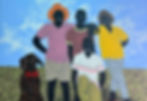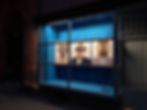
"Tipo Passe" is an ongoing series by Angolan photographer Edson Chagas that explores themes of history, culture, and identity. Chagas stages portraits of models wearing traditional African masks sourced from local markets, paired with contemporary secondhand clothing, creating a compelling blend of past and present. Chagas establishes a visual dialogue that bridges disparate worlds—traditional and modern, ritual and banal. This series was also on view in Budapest at Cairo Contemporary, which encourages a dialogue about the interplay between societal heritage and contemporary life.

What is the story behind this series?
My interest piqued while I was photographing a friend's art collection. He also had such masks in his collection, which he bought from market vendors. Many guests expressed fear when seeing these objects during gatherings at the collection space.
In one instance, I playfully put on a mask, and one of the guests became agitated, telling me I shouldn't be playing with it because I could die.
This interaction sparked my interest in how we perceive these objects and how much we know about them.
The idea for the portraits came to mind while I was renewing my Angolan passport. I visited a local photography shop to have my portrait taken, and in Angola, normally you need to have a tight, nice portrait taken for a passport. While I was about to have my portrait taken I had no suit or a suitable outfit for the occasion so I asked them if they would have suitable clothes because normally photography shops would have suitable clothing available. Still, instead they had a group of pictures with suits on it and that was what they used connecting with the portrait they took from me, that really sparked me and ultimately, this approach led me to create these series of portraits, using models, African masks (Bantu) and clothes, were both objects have something in common which is being objects that are purchased from the market space.

How should we see these masks?
Acquiring these masks from markets already removes them from their original context, so by interacting with them in this manner, using the language of passport portraiture, I create a new context where they act as living entities, revealing their own characters and assuming mixed names that blend colonial origin names with African origin names. However, they still embody historical significance while simultaneously serving as personalities in today's world. They hold both the past and the present that duel in a space called the world.

How did you choose the masks for your photos?
I was interested in the ones that could resemble familiar faces; choosing them felt more like shopping rather than a sacred experience. Encountering the masks at the market felt like I was looking at souvenirs that still reflect their historical representation but not their culturally profound meaning. I got some in local markets in Luanda, and others in South Africa, and one in Ghana.
For me these particular masks that I photographed can also highlight the migration theme within Africa, as many that could resemble a specific ethnic group but its original region are shared by more than one country.
For instance, the Chokwe initially came from a region shared today by three countries: Angola, the Democratic Republic of the Congo, and Zambia. Additionally, the Chokwe mask can be found in various local markets throughout the African continent.
How do you balance between the ritual function and the banality?
I wanted to convey the paradox and duality I felt throughout the experience I had with one of the guests, as I said before. Most of the clothing was bought from local markets and secondhand shops. In Angola, we call “fardo” the piles of clothing sent to Africa from the West in big sacks, and in Luanda, you can find those piles of clothing in different local markets. As I mentioned earlier, the masks also come from local markets, and the ones that will be shown, I purchased from a local market in Luanda. So, in a way, both come from a space of trading.
You mentioned these masks evoke ambivalent feelings.
Many people share a strong connection between certain objects and themes regarding the masks. Some would feel comfortable and positive around them, others would be afraid of some sort of negativity. This feeling often arises from a lack of understanding. Photographing these items with these clothes creates a dynamic that is both new and strange, eliciting various emotions like love or fear. This prompts more profound curiosity in viewers, leading them to explore further.

What was your main focus during the process?
Portraits for identification purposes, what's important is your face, along with the upper part of your torso. This was my focus during the process. However, I used models and sometimes adjusted the positioning based on the posture of the model wearing the mask. I chose individuals with more extended shoulders to create a balance, as the masks I used were quite large. Most of the portraits I created are quite frontal, but I also made a few with different angles to capture some varying body expressions. My goal was to ensure that the subjects conveyed an expression, making each image more dynamic and engaging rather than just a straightforward shot. The selection of the clothing came after selecting clothes that had some sort of connection through color or lines that would naturally evolve with the masks.

What do you think about the connection between decontextualization and colonialism?
I exhibited the Tipo Passe series in Angola, where people indicated that it was essential to display this series of Bantu masks, even though I was presenting in a different context; many people were unfamiliar with most of them. People were more familiar with those that would resonate with the Chokwe, as they are also very common in Angola and are part of Angolan cultural heritage. There is a difference: most of the Masks and other objects from Africa that we can see in Western museums were stolen during colonization and taken from their original context and space. There is a big difference between looting and buying them from a local market. However, it is essential to note today that most clients or buyers of these masks are primarily tourists from Europe and other parts of the world, rather than locals.
Angola was a Portuguese colony until 1975. How did this historical event form your identity?
That's a good question. It's very complex because my family is a mixture of Angolans and Portuguese, from both my mother's and father's sides. I was born in Angola after independence, in 1977, so I did not experience colonialism directly. However, after independence, the country was hit by a civil war - a social conflict - which lasted for around 27 years, and that had a direct impact on my life.
I think while growing up it was when I realized how colonialism can create a stigmatization of identity is like living in constant historical shock.
It's like living in a body that was born in a country full of hidden stories that you must keep unfolding as you go through life. Ironically, the language that separated us is the language that is somehow that supposably “unify” us, Portuguese is the official national language, but Angola is a country with more than twenty national languages. Still, nine are the most spoken this is more evident in the capital were most of us in Luanda don’t speak any of them, till now we don’t learn none of them in schools. Using just this example regarding language, it feels like colonialism never left, like a shadow in the back of my head.

What do you think about identity in general?
In my case, I would say a “ping pong ball” experience, I have been moving between Angola and Portugal since a very young age, but was when I was around 15 that I moved to Lisbon in 1992 and lived there for 11 years without going back to Angola, not even for holidays, somehow I experienced Angola in a different environment, through food, music, and gatherings with family, friends also came to interact closely with other African communities, and with the Portuguese culture too. For this reason, when I returned to my home country, some people would tell me that I was not entirely from there. However, it no longer bothers me that we cannot forget where we come from and our own culture. Living in a different country or environment inevitably will have an impact, so I see identity as much more dynamic and fluid.

What do you think about these photos from a gender perspective?
It's interesting because in most African cultures, women are not allowed to actively participate in or use masquerade activities, even those that resonate with ceremonies related to women. Of course, I am talking about the ones that are related to real ceremonies or rituals, which is not the case with my images, the masks come from a different environment which is the market space, a space where the masks do not carry such significance. The first images I created resembled three businessmen, and I am continuing the project. I made other portraits in relation to women and the work is ongoing so the gender process will be even more evident. It's fascinating to also think about this project in gender terms, as it prompts consideration of which masks might resonate with men, women, or individuals of other gender identities.
How does this series deal with the notion of vulnerability?
I recall that as a photojournalism student in England, most of the photography we saw from Africa was related to war, starvation, or nature, with lions being the superstars. It should be noted that such issues should be addressed because they are likely to occur; however, the news media has emphasized chiefly the vulnerable aspects, which has created a stigmatization of the continent.
Now, we are turning the lens inwards, we are also our own critics and visualize and express our own vulnerabilities and anxieties on our terms.
However, it's essential to clarify that you don't need to be from a particular place to create work about that same place, as long as it deals with these issues or not. Being that said I don’t feel that with this series that’s the case; the series comes from a personal experience. Without that experience, this project probably would not have been done by me.

This series was exhibited in several museums in different ways. What was your favorite?
That's a tough question because the spaces somehow dictate different possibilities. It’s true that this series has been exhibited in several museums and various ways, both indoors and outdoors, and each has had a different impact, with some featuring a smaller number of images and others a larger number. I would say that the shows that had a larger number of images are the ones I would point out as “favorites” and more recently I would say the exhibition at TATE Modern, “A World in Common”, contemporary African photography, had a larger number of images and was installed with a set of gaps between the groups of pictures. For me the gaps highlighted also a certain connection between presence and absence. The other one was even more recent, at the Biennial of Images VEVEY, (dis)Connected, in Switzerland, the work was shown outdoors, in a passerby area just on the side of lake Léman.

Edson Chagas was born in 1977 in Luanda, Angola, and lives between Angola and Portugal. He studied photography at the University of Wales in Newport, London College of Communication, and Portugal's Escola Técnica de Imagem e Comunicação and Centro Comunitário de Arcena. In 2013, Chagas's Found Not Taken series was exhibited at the Angolan Pavilion at the 55th Venice Biennale, which won the Golden Lion for best national pavilion.







